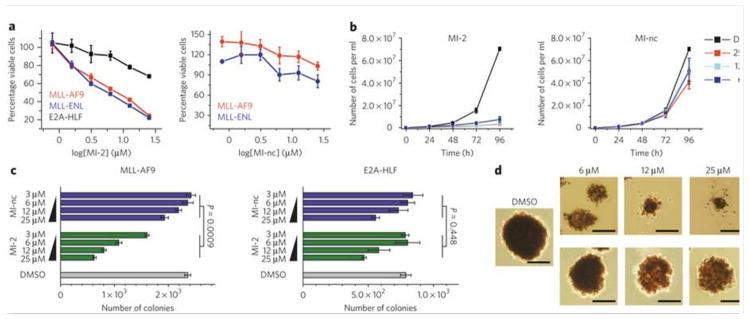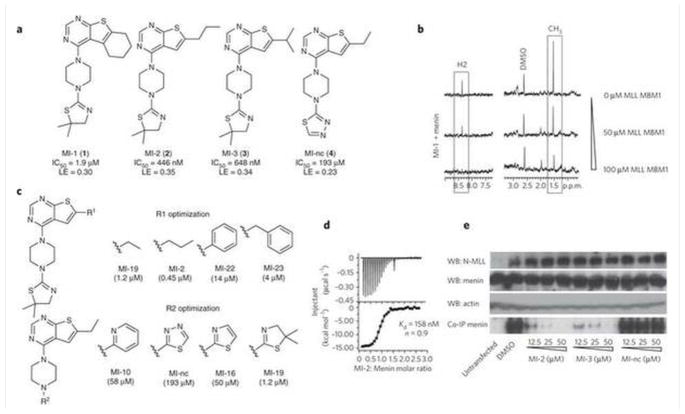
| Size | Price | Stock | Qty |
|---|---|---|---|
| 5mg |
|
||
| 10mg |
|
||
| 25mg |
|
||
| 50mg |
|
||
| 100mg |
|
||
| 250mg |
|
||
| 500mg | |||
| Other Sizes |
Purity: ≥98%
MI-2 (MI2, Menin-MLL Inhibitor) is a novel, potent and selective inhibitor of menin-MLL interaction with antineoplastic activity. It inhibits menin-MLL interaction with an IC50 of 446 nM. MI-2 acts by binding to the wild-type menin but doesn't bind M278K and Y323K menin mutants. In HEK293 cells transfected with Flag-MLL-AF9, MI-2 effectively inhibited the menin-MLL-AF9 interaction without affecting the expression level of menin and MLL-AF9.
| ln Vitro |
The menin-MLL inhibitor MI-2, with GI50 values of approximately 5 μM, very efficiently inhibits the proliferation of MLL-AF9 and MLL-ENL transduced BMC. Several compounds with IC50 values in the nanomolar range were developed as a result of the assessment of various hydrophobic groups at R1. These compounds include MI-2 (IC50= 446±28 nM) and MI-3 (IC50= 648±25 nM). The dissociation constants (Kd=158 nM for MI-2) for the menin-MLL inhibitors have been measured at the nanomolar range. Inhibiting the menin-MLL-AF9 connection in human cells is a highly effective way that MI-2 can access the protein target. Moreover, MI-2 exhibits minimal impact on the proliferation of BMC transduced with E2A-HLF (GI50>50 μM). This could potentially be attributed to the inhibition of menin interaction with wild-type MLL. After MI-2 treatment, GI50 values for MV4;11 (harboring MLL-AF4; GI50=9.5 μM), KOPN-8 (MLL-ENL; GI50=7.2 μM), ML-2 (MLL-AF6; GI50=8.7 μM), and MonoMac6 (MLL-AF9; GI50=18 μM) are less than 10 μM[1].
|
||
|---|---|---|---|
| ln Vivo |
|
||
| Animal Protocol |
|
||
| References | |||
| Additional Infomation |
4-[4-(5,5-dimethyl-4H-thiazol-2-yl)-1-piperazinyl]-6-propylthieno[2,3-d]pyrimidine is a N-arylpiperazine and a thienopyrimidine.
|
| Molecular Formula |
C18H25N5S2
|
|
|---|---|---|
| Molecular Weight |
375.55
|
|
| Exact Mass |
375.155
|
|
| CAS # |
1271738-62-5
|
|
| Related CAS # |
|
|
| PubChem CID |
54765302
|
|
| Appearance |
Light yellow to yellow solid powder
|
|
| Density |
1.4±0.1 g/cm3
|
|
| Boiling Point |
538.0±60.0 °C at 760 mmHg
|
|
| Flash Point |
279.2±32.9 °C
|
|
| Vapour Pressure |
0.0±1.4 mmHg at 25°C
|
|
| Index of Refraction |
1.712
|
|
| LogP |
3.59
|
|
| Hydrogen Bond Donor Count |
0
|
|
| Hydrogen Bond Acceptor Count |
6
|
|
| Rotatable Bond Count |
4
|
|
| Heavy Atom Count |
25
|
|
| Complexity |
504
|
|
| Defined Atom Stereocenter Count |
0
|
|
| InChi Key |
SRQYLNYQAPCPIR-UHFFFAOYSA-N
|
|
| InChi Code |
InChI=1S/C18H25N5S2/c1-4-5-13-10-14-15(20-12-21-16(14)24-13)22-6-8-23(9-7-22)17-19-11-18(2,3)25-17/h10,12H,4-9,11H2,1-3H3
|
|
| Chemical Name |
4-[4-(5,5-dimethyl-4H-1,3-thiazol-2-yl)piperazin-1-yl]-6-propylthieno[2,3-d]pyrimidine
|
|
| Synonyms |
|
|
| HS Tariff Code |
2934.99.9001
|
|
| Storage |
Powder -20°C 3 years 4°C 2 years In solvent -80°C 6 months -20°C 1 month |
|
| Shipping Condition |
Room temperature (This product is stable at ambient temperature for a few days during ordinary shipping and time spent in Customs)
|
| Solubility (In Vitro) |
|
|||
|---|---|---|---|---|
| Solubility (In Vivo) |
Solubility in Formulation 1: ≥ 2.5 mg/mL (6.66 mM) (saturation unknown) in 10% DMSO + 40% PEG300 + 5% Tween80 + 45% Saline (add these co-solvents sequentially from left to right, and one by one), clear solution.
For example, if 1 mL of working solution is to be prepared, you can add 100 μL of 25.0 mg/mL clear DMSO stock solution to 400 μL PEG300 and mix evenly; then add 50 μL Tween-80 to the above solution and mix evenly; then add 450 μL normal saline to adjust the volume to 1 mL. Preparation of saline: Dissolve 0.9 g of sodium chloride in 100 mL ddH₂ O to obtain a clear solution. Solubility in Formulation 2: ≥ 2.5 mg/mL (6.66 mM) (saturation unknown) in 10% DMSO + 90% (20% SBE-β-CD in Saline) (add these co-solvents sequentially from left to right, and one by one), clear solution. For example, if 1 mL of working solution is to be prepared, you can add 100 μL of 25.0 mg/mL clear DMSO stock solution to 900 μL of 20% SBE-β-CD physiological saline solution and mix evenly. Preparation of 20% SBE-β-CD in Saline (4°C,1 week): Dissolve 2 g SBE-β-CD in 10 mL saline to obtain a clear solution. View More
Solubility in Formulation 3: ≥ 2.5 mg/mL (6.66 mM) (saturation unknown) in 10% DMSO + 90% Corn Oil (add these co-solvents sequentially from left to right, and one by one), clear solution. |
| Preparing Stock Solutions | 1 mg | 5 mg | 10 mg | |
| 1 mM | 2.6628 mL | 13.3138 mL | 26.6276 mL | |
| 5 mM | 0.5326 mL | 2.6628 mL | 5.3255 mL | |
| 10 mM | 0.2663 mL | 1.3314 mL | 2.6628 mL |
*Note: Please select an appropriate solvent for the preparation of stock solution based on your experiment needs. For most products, DMSO can be used for preparing stock solutions (e.g. 5 mM, 10 mM, or 20 mM concentration); some products with high aqueous solubility may be dissolved in water directly. Solubility information is available at the above Solubility Data section. Once the stock solution is prepared, aliquot it to routine usage volumes and store at -20°C or -80°C. Avoid repeated freeze and thaw cycles.
Calculation results
Working concentration: mg/mL;
Method for preparing DMSO stock solution: mg drug pre-dissolved in μL DMSO (stock solution concentration mg/mL). Please contact us first if the concentration exceeds the DMSO solubility of the batch of drug.
Method for preparing in vivo formulation::Take μL DMSO stock solution, next add μL PEG300, mix and clarify, next addμL Tween 80, mix and clarify, next add μL ddH2O,mix and clarify.
(1) Please be sure that the solution is clear before the addition of next solvent. Dissolution methods like vortex, ultrasound or warming and heat may be used to aid dissolving.
(2) Be sure to add the solvent(s) in order.
| NCT Number | Recruitment | interventions | Conditions | Sponsor/Collaborators | Start Date | Phases |
| NCT04856254 | Not yet recruiting | Procedure: Trial of labor after cesarean section |
Previous Cesarean Section Scar | Mansoura University | August 1, 2020 | Not Applicable |
| NCT05933993 | Recruiting | Other: Elective cesarean section | Cesarean Section Complications | Sygehus Lillebaelt | September 2023 | |
| NCT03967028 | Completed | Procedure: cesarean section | CESAREAN SECTION | Assiut University | November 5, 2019 | |
| NCT04948892 | Recruiting | Other: Prescence of the father during cesarean section in general anesthesia |
Cesarean Section | Sygehus Lillebaelt | January 1, 2022 |
|
 |
 |